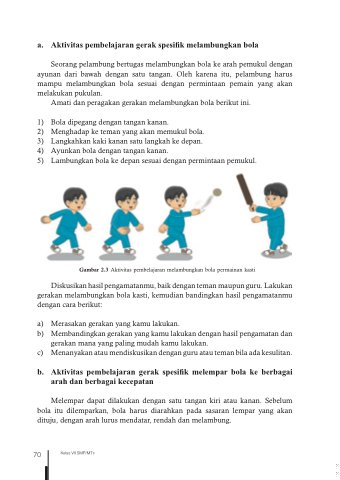
In the game of baseball, seorang pelambung bertugas melambungkan bola ke arah pemukul dengan ayunan dari. This essential role requires precision, focus, and timing. As the pitcher gears up, they must analyze the batter’s stance and tendencies, crafting the perfect pitch to outsmart their opponent. Each throw holds the potential to change the course of the game, making the pitcher’s duty both thrilling and crucial. Understanding this dynamic adds depth to the excitement on the field and highlights the intricate dance between pitcher and batter.
Seorang Pelambung Bertugas Melambungkan Bola ke Arah Pemukul dengan Ayunan dari
In the exciting world of baseball, the role of the pitcher, or “pelambung”, is crucial to the game. This player stands on the mound, focusing intently on throwing the ball towards the batter. The art of pitching is an intricate dance of skill, strategy, and physical prowess. In this article, we will explore the responsibilities of a pelambung, the techniques and strategies they employ, and the impact they have on the game.
The Role of the Pelambung in Baseball
The pelambung, or pitcher, performs several key functions that shape the game’s outcome. Here are the primary responsibilities of a pelambung:
- Throwing the Ball: The primary duty of the pelambung is to throw the ball toward the pemukul (batter) with the aim of getting them out. This involves delivering the ball with precision and speed.
- Strategizing: The pelambung must think quickly and adjust their pitching style based on the batter’s strengths and weaknesses. This requires a deep understanding of both the game and the players.
- Controlling the Game: A skilled pelambung can dictate the pace of the game. By throwing strikes and keeping the batters off balance, they help maintain the team’s advantage.
- Communicating: The pelambung works closely with the catcher to decide on the best pitches to throw. This partnership is crucial for success on the mound.
Key Pitching Techniques
To excel as a pelambung, one must master several pitching techniques. Here, we delve into some of the most important ones:
Fastball
The fastball is one of the most fundamental pitches in baseball. It is characterized by:
- Speed: Fastballs are thrown with maximum velocity, often exceeding 90 miles per hour.
- Straight Delivery: This pitch travels directly to the strike zone, making it challenging for batters to hit.
Curveball
The curveball adds variety and deception to a pelambung’s repertoire. Its main features include:
- Changing Trajectory: The curveball drops as it nears the plate, making it difficult for batters to predict its path.
- Slower Speed: This pitch is typically slower than a fastball, catching batters off guard.
Slider
The slider combines elements of both the fastball and the curveball. Its characteristics include:
- Sharp Movement: The slider moves laterally, often deceiving batters who expect a fastball.
- Quick Delivery: Thrown at a high speed, sliders are challenging for batters to adjust to in time.
Changeup
The changeup is essential for tricking batters. It is notable for:
- Deceptive Speed: This pitch is thrown slower than a fastball, surprising batters who are ready to swing.
- Timing: A well-timed changeup can lead to easy outs.
The Mental Game of Pitching
Pitching isn’t just about physical skills; it also requires a strong mental aspect. Here’s what a pelambung must consider:
Reading the Batter
Understanding the batter’s approach is vital to successful pitching. Here are some strategies:
- Watch Their Stance: A batter’s stance can give clues about their strengths and weaknesses.
- Analyze Previous At-Bats: Observing how a batter has performed in past at-bats can inform pitching strategies.
Maintaining Composure
The pressure on a pelambung can be intense, especially in critical game situations. Here are some tips for staying calm:
- Breathe: Taking deep breaths can help reduce anxiety before delivering a pitch.
- Focus on the Process: Concentrating on the mechanics of pitching rather than the outcome can enhance performance.
Team Collaboration
A successful pelambung does not work alone; collaboration with teammates, especially the catcher, is essential. Here’s how they work together:
The Catcher’s Role
The catcher plays a crucial role in guiding the pelambung. Key points include:
- Signaling Pitches: The catcher often signals which pitch to throw based on the batter’s tendencies and the game situation.
- Catcher’s Frame: A good catcher frames pitches to make strikes appear more appealing to the umpire.
Fielding Responsibilities
The pelambung also has fielding duties after delivering the pitch. Here’s what to focus on:
- Backing Up Plays: After throwing, the pelambung must be ready to field any balls that are hit back towards them.
- Positioning: Good positioning can make it easier to field ground balls or catch line drives.
Training and Practice
Becoming a skilled pelambung takes dedication and practice. Here are some training exercises and techniques:
Drills for Pitching
Effective drills can enhance a pelambung’s skills. Consider the following:
- Long Toss: This drill improves arm strength and helps develop throwing mechanics.
- Pitching Against a Wall: Practicing throwing against a wall helps refine accuracy and mechanics.
Conditioning
Physical conditioning is vital for a pelambung. Focus on:
- Strength Training: Building strength in the legs, core, and arms supports better pitching performance.
- Flexibility Exercises: Stretching improves overall flexibility, reducing the risk of injury.
Pitching Strategy in Games
During a game, the pelambung must adapt their strategy based on various factors. Some important considerations include:
Game Situation
Understanding the context of the game helps shape pitching decisions. Key aspects to consider are:
- Score: If the team is ahead, the pelambung may focus on throwing strikes to limit base runners.
- Inning: In late innings, a pelambung may adopt more aggressive pitching to secure the win.
Adjusting to Batters
As the game progresses, the pelambung must be ready to adjust their approach. Here are some tips:
- Mixing Pitch Types: Varying pitch types keeps the batter guessing and less able to anticipate the next pitch.
- Changing Locations: Throwing pitches to different parts of the strike zone can disrupt the batter’s timing.
Common Challenges for Pelambung
Pelambung face a variety of challenges during a game. Here are some common obstacles they encounter:
Pressure Situations
Pitching in high-pressure scenarios can be daunting. Here’s how to manage:
- Stay Focused: Concentrating on the mechanics of pitching rather than the stakes of the game can help alleviate pressure.
- Trust Your Training: Relying on training and practice can boost confidence in challenging moments.
Injuries
Injuries can pose a significant threat to a pelambung’s career. Preventative measures include:
- Proper Warm-Up: Prior to throwing, engaging in a thorough warm-up routine helps prevent injuries.
- Listening to Your Body: Recognizing signs of fatigue or pain and resting as necessary is essential for long-term health.
The Impact of Technology on Pitching
Modern technology has significantly influenced how pelambung train and perform. Key developments include:
Performance Analysis
Analytical tools help pelambung assess their performance. Some benefits include:
- Video Analysis: Reviewing footage of pitching mechanics allows pelambung to identify areas for improvement.
- Data Analytics: Understanding statistics related to pitch effectiveness assists in strategy development.
Training Aids
Innovative training tools enhance pitching skills. Consider these examples:
- Pitching Machines: These machines allow pelambung to practice against varying pitch speeds and types.
- Weighted Balls:
PJOK kls 7 bab 2 part 1 lanjutan
Frequently Asked Questions
What techniques can a pitcher use to improve their throws to the batter?
A pitcher can enhance their throwing techniques by focusing on their grip, stance, and follow-through. Using a proper grip allows better control of the ball’s spin and direction. The stance should be balanced to ensure stability during the throw. Incorporating drills that emphasize arm speed and body rotation can also help in throwing the ball more effectively toward the batter.
How does the pitcher’s angle affect the game’s outcome?
The angle at which a pitcher throws can significantly influence the batter’s ability to hit the ball. A lower pitch may result in grounders while a higher pitch can lead to pop-ups. Additionally, varying the pitch angles keeps the batter guessing, increasing the chance of getting them out. A pitcher should learn to adjust their angles based on the batter’s strengths and weaknesses.
What role does the pitcher’s mental approach play in their performance?
A pitcher’s mental approach is crucial for maintaining focus and confidence during a game. Visualization techniques can help pitchers anticipate different scenarios and prepare for them. Staying calm under pressure also contributes to better decision-making, leading to effective pitches. A strong mental game allows pitchers to bounce back from setbacks and perform consistently.
What strategies can a pitcher use to outsmart a batter?
A pitcher can employ several strategies to outsmart a batter, such as mixing up pitch types and speeds. For example, alternating between fastballs and curveballs can disrupt a batter’s timing. Additionally, throwing pitches to different locations of the strike zone can keep the batter off balance. Observing the batter’s stance and swing can also provide insights into which pitches might be most effective.
How does teamwork between the pitcher and catcher impact play?
The collaboration between the pitcher and catcher is vital for executing game strategies effectively. The catcher provides signs that indicate pitch types and locations, which helps the pitcher to focus on specific targets. Good communication ensures that both players are on the same page, enhancing the overall gameplay. Their synergy can lead to better pitch selection and defensive strategies.
Final Thoughts
Seorang pelambung bertugas melambungkan bola ke arah pemukul dengan ayunan dari berbagai sudut dan kecepatan. Tugas ini menuntut ketepatan dan keterampilan tinggi, karena setiap keputusan pelambung dapat mempengaruhi hasil permainan. Dalam setiap pertandingan, pelambung harus mempersiapkan diri untuk menghadapi berbagai strategi dari pemukul dan tim lawan. Keberhasilan tim sering kali bergantung pada kemampuan pelambung dalam mengatur ritme permainan dan mengendalikan bola dengan baik.




